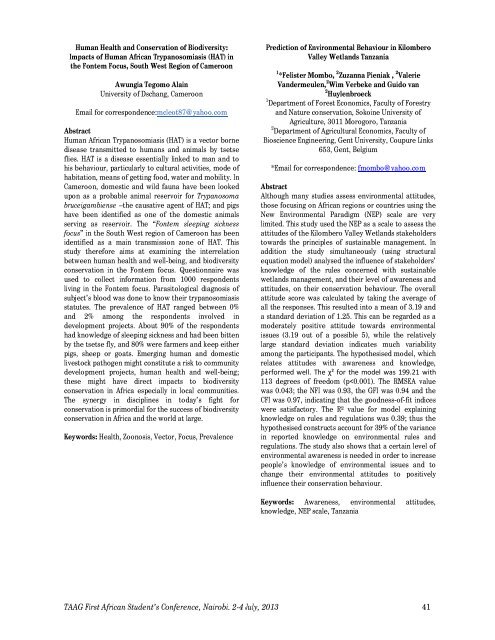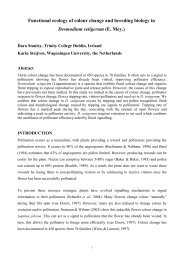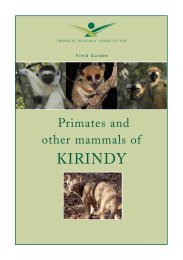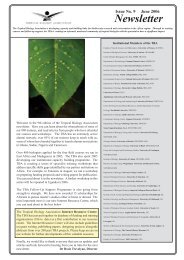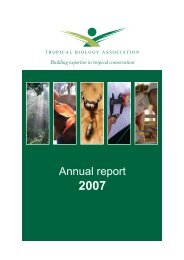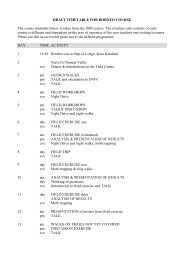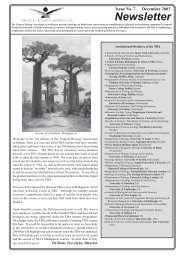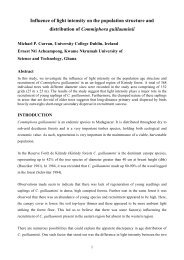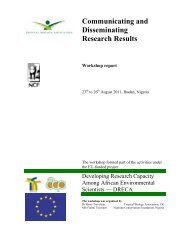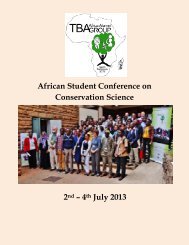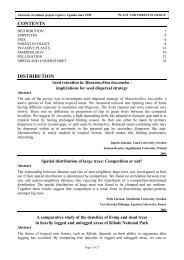Download TAAG Book of Abstracts - Tropical Biology Association
Download TAAG Book of Abstracts - Tropical Biology Association
Download TAAG Book of Abstracts - Tropical Biology Association
You also want an ePaper? Increase the reach of your titles
YUMPU automatically turns print PDFs into web optimized ePapers that Google loves.
Human Health and Conservation <strong>of</strong> Biodiversity:<br />
Impacts <strong>of</strong> Human African Trypanosomiasis (HAT) in<br />
the Fontem Focus, South West Region <strong>of</strong> Cameroon<br />
Awungia Tegomo Alain<br />
University <strong>of</strong> Dschang, Cameroon<br />
Email for correspondence:mcleot87@yahoo.com<br />
Abstract<br />
Human African Trypanosomiasis (HAT) is a vector borne<br />
disease transmitted to humans and animals by tsetse<br />
flies. HAT is a disease essentially linked to man and to<br />
his behaviour, particularly to cultural activities, mode <strong>of</strong><br />
habitation, means <strong>of</strong> getting food, water and mobility. In<br />
Cameroon, domestic and wild fauna have been looked<br />
upon as a probable animal reservoir for Trypanosoma<br />
bruceigambiense –the causative agent <strong>of</strong> HAT; and pigs<br />
have been identified as one <strong>of</strong> the domestic animals<br />
serving as reservoir. The “Fontem sleeping sickness<br />
focus” in the South West region <strong>of</strong> Cameroon has been<br />
identified as a main transmission zone <strong>of</strong> HAT. This<br />
study therefore aims at examining the interrelation<br />
between human health and well-being, and biodiversity<br />
conservation in the Fontem focus. Questionnaire was<br />
used to collect information from 1000 respondents<br />
living in the Fontem focus. Parasitological diagnosis <strong>of</strong><br />
subject’s blood was done to know their trypanosomiasis<br />
statutes. The prevalence <strong>of</strong> HAT ranged between 0%<br />
and 2% among the respondents involved in<br />
development projects. About 90% <strong>of</strong> the respondents<br />
had knowledge <strong>of</strong> sleeping sickness and had been bitten<br />
by the tsetse fly, and 80% were farmers and keep either<br />
pigs, sheep or goats. Emerging human and domestic<br />
livestock pathogen might constitute a risk to community<br />
development projects, human health and well-being;<br />
these might have direct impacts to biodiversity<br />
conservation in Africa especially in local communities.<br />
The synergy in disciplines in today’s fight for<br />
conservation is primordial for the success <strong>of</strong> biodiversity<br />
conservation in Africa and the world at large.<br />
Keywords: Health, Zoonosis, Vector, Focus, Prevalence<br />
Prediction <strong>of</strong> Environmental Behaviour in Kilombero<br />
Valley Wetlands Tanzania<br />
1 *Felister Mombo, 2 Zuzanna Pieniak , 2 Valerie<br />
Vandermeulen, 2 Wim Verbeke and Guido van<br />
2 Huylenbroeck<br />
1 Department <strong>of</strong> Forest Economics, Faculty <strong>of</strong> Forestry<br />
and Nature conservation, Sokoine University <strong>of</strong><br />
Agriculture, 3011 Morogoro, Tanzania<br />
2 Department <strong>of</strong> Agricultural Economics, Faculty <strong>of</strong><br />
Bioscience Engineering, Gent University, Coupure Links<br />
653, Gent, Belgium<br />
*Email for correspondence: fmombo@yahoo.com<br />
Abstract<br />
Although many studies assess environmental attitudes,<br />
those focusing on African regions or countries using the<br />
New Environmental Paradigm (NEP) scale are very<br />
limited. This study used the NEP as a scale to assess the<br />
attitudes <strong>of</strong> the Kilombero Valley Wetlands stakeholders<br />
towards the principles <strong>of</strong> sustainable management. In<br />
addition the study simultaneously (using structural<br />
equation model) analysed the influence <strong>of</strong> stakeholders’<br />
knowledge <strong>of</strong> the rules concerned with sustainable<br />
wetlands management, and their level <strong>of</strong> awareness and<br />
attitudes, on their conservation behaviour. The overall<br />
attitude score was calculated by taking the average <strong>of</strong><br />
all the responses. This resulted into a mean <strong>of</strong> 3.19 and<br />
a standard deviation <strong>of</strong> 1.25. This can be regarded as a<br />
moderately positive attitude towards environmental<br />
issues (3.19 out <strong>of</strong> a possible 5), while the relatively<br />
large standard deviation indicates much variability<br />
among the participants. The hypothesised model, which<br />
relates attitudes with awareness and knowledge,<br />
performed well. The χ² for the model was 199.21 with<br />
113 degrees <strong>of</strong> freedom (p


